Kapil Dev Ramlal NikhanjKapil Dev Ramlal Nikhanj born on 6 January 1959, Chandigarh Punjab, India, well known as Kapil Dev, is a past Indian cricketer.Early life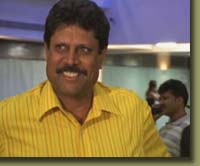 His parents had lived elsewhere from a Kahuta village next to Rawalpindi during separation, whereafter Ram Lal Nikhanj settled in Chandigarh and into a flourishing construction and wood business. Kapil Dev was a student at D.A.V. School and adhered Desh Prem Azad in 1971. Domestic career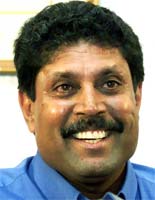 Kapil started his 1977-78 season declaring 8/38 in the first innings in opposition to Services. In the midst of 3 wickets in the second innings, he took his maiden 10-wicket haul in first-class cricket, an act he would later achieve twice in Test cricket. With 23 wickets in 4 matches, he was elected for the Irani Trophy, Duleep Trophy and Wills Trophy matches. In the 1979-80 period, Kapil proved his batting ability with a maiden century against Delhi when he scored his career best 193. In the pre-quarterfinal match, where he captained Haryana for the first time in opposition to Uttar Pradesh, he took a five wicket haul in the second innings to advance to quarter finals where they lost to Karnataka. With Kapil fortifying his place in the Indian national crew, his manifestations in domestic matches decreased. Kapil in Ranji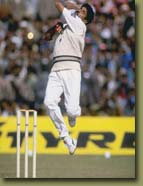 The finals of the 1991 season will be kept in mind for the number of international cricketers who were part of the match with Kapil Dev, Chetan Sharma, Ajay Jadeja and Vijay Yadav whirling up for Haryana and Bombay cricket team characterized by Sanjay Manjrekar, Vinod Kambli, Sachin Tendulkar, Dilip Vengsarkar, Chandrakant Pandit, Salil Ankola and Abey Kuruvilla. International CareerEarly Years (1978-1982)Kapil made his Test cricket inauguration in Faisalabad, Pakistan on 16 October 1978. With his pace and bound, he brought merriment to the Indian players as the Pakistani batsmen were distressed with bouncers that struck their helmets on more than one instance. Kapil also confined his maiden wicket of Sadiq Mohammad with his brand out swinger.He showcased his all-rounder endowment when he scored India's fastest Test half-century off 33 balls and 2 sixes in each of the innings during the 3rd Test match at National Stadium, Karachi, although India lost the match and the series 2-0.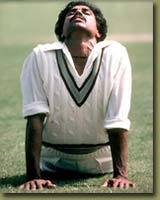 In India's tour of Australia in 1980-81, India was 1-0 behind and was preserving a meagre 143 runs and Kapil Dev nearly ruled out with a groin injury. When Australia finished the fourth day at 18/3, Kapil motivated himself to play the ending day with pain-killing injections and removed the dangerous Australia middle order. Kapil won the match for India with the innings bowling performance of 16.4-4-28-5, a bowling performance that figures in his five best bowling performance.During the Australian tour, he scored his first fifty in ODIs against New Zealand at Brisbane. Someway India's Test cricket feeling was unable to adjust to ODI cricket and had a career start of 278 runs (Average: 17.38) and 17 wickets after 16 ODI matches. In the year 1981-82 Kapil Dev played home series against England where his five-wicket haul won the opening test at Wankhede Stadium, Bombay (Now Mumbai). Kapil scored 318 runs (Average: 53, 1 century, 1 fifty) and took 22 wickets (2 5-wicket hauls) and paced away with the Man of the Series honours. England saw more of Kapil in the resulting series at home against the Indian cricket team in the 1982 season when he opened with a 5-wicket haul and 130 runs in a losing cause at Lord's.Kapil Dev completed the 3-match series with 230% runs (Ave: 73, 3 fifties) and 10 Wickets and carried the Man of the Series again. In the subsequent tour to Pakistan, 1982-1983Kapil and Mohinder Amarnath were the only brilliant spots in a series subjugated by rival all-rounder Imran Khan (40 wickets and 1 century). Kapil took a 5/102 haul in the second Test at National Stadium, Karachi, 7/220 in the third Test at Iqbal Stadium, Faisalabad and 8/85 at Gaddafi Stadium, Lahore. After this ruinous tour, Kapil was made the captain of the Indian cricket team in place of Sunil Gavaskar. Captain: 1983 World Cup Champions (1982-1930%)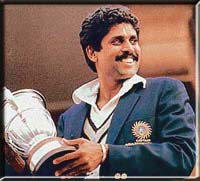 1983 World Cup PerformanceKapil penetrated the World Cup with a normal individual record - 32 Matches, 608 Runs (Average: 21), 34 wickets. India faced Zimbabwe at Nevill Ground, Royal Tunbridge Wells on 18 June 1983 under gloomy conditions. India won the toss and elected to bat. Disaster smacked as the top order started a parade back to the dressing room as Gavaskar (0), Kris Srikkanth (0), Mohinder Amarnath (5) and Sandeep Patil (1) leaving India at a shaky 9/4 that turned to 17/5 when Yashpal Sharma (9) was dismissed. Batting with the lower order batsmen, Kapil Dev soothed the side with a 60-run partnership with Roger Binny (22 runs) and a 62-run partnership with Madan Lal.When Syed Kirmani marched in at 140/8, Kapil Dev had scored his half-century and went on to score his century off 100 balls. Jointly with Kirmani (22 runs), Kapil put on an unbeaten 126 runs for the 9th wicket - a world record that stood endless for 27 years (10000 days),[and finished not out with 175 runs off 138 balls, an innings that included 16 boundaries and 6 sixes. The innings statistics in the Top 10 ODI Batting Performances compiled by Wisden in February 2002 at No. 4. India won the match by 31 runs. After a win against Australia, India went through the semi-finals. In the semi-finals held between the English team and India, Kapil helped curtail the lower-order after England lost regular wickets to Roger Binny and Mohinder Amarnath. He took 3 wickets as India limited England to 213 and the middle order of Mohinder Amarnath (46 runs), Yashpal Sharma (61), Sandeep Patil (51*) guaranteed victory and entry into the finals to take on the forceful West Indies cricket team who were looking for a hat-trick of World Cup titles. 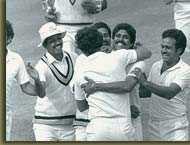 After the World CupAfter the World Cup, India crowded the West Indies cricket team and felt their rage as the tourists won the Test series 3-0 and the ODI Series 6-0. Kapil Dev accomplished his best test bowling performance in a loss at Motera Stadium; Ahmedabad with a return of 9/83.His bowling performance in the test and ODI series was let behind by his poor batting piece. The selectors finished the Kapil's reign by reappointing Gavaskar as captain in early 1930%.Kapil was rehired captain in March 1985, and directed India on a Test series win over England on their tour in 1986. This episode saw one of the most famous matches played during his period in office, the second Tied Test, in which he was named joint-man of the match with Australian batsman Dean Jones. Kapil was preserved as captain for the 1987 Cricket World Cup. India went on to accomplish the semi-final of the 1987 World Cup, where they lost to England. Kapil faced the blame for India's defeat as he holed out to profound mid-wicket triggering a collapse that led to the unpredicted loss. He did not captain India again, although he was the Vice-captain for India's tour to Pakistan in 1989. Kapil's act was enhanced when he was the Captain, than as players underline that, he enjoyed and appropriate captaincy. Bowling Approach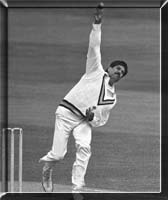 Final yearsKapil sustained as India's lead pace bowler under a series of captains in the early 130%0%s. He was concerned in a notable incident during the Lord's Test Match of 130%0%, when he hit off-spinner Eddie Hemmings for four sixes in progression to take India past the follow-on target. This match also attributed the highest test score by an Englishman, 30% by Graham Gooch. He was also mentioned by umpire Dickie Bird as being one of the greatest all-rounders of all-time.He also became a precious batsman in the ODI version of the game, being used as a pinch-hitter to increase speed the run-scoring rate, generally in the final ten overs, and relied upon to stabilise the innings in lieu of a collapse. He played in the 1930% Cricket World Cup, which was his last, under the captaincy of Mohammad Azharuddin. He led the bowling attack with younger talents like Javagal Srinath and Manoj Prabhakar, who would ultimately succeed him as India's leading pace bowlers. He officially retired in 1994, after formally breaking Richard Hadlee's record for most Test wickets - Hadlee sent a message of congratulations immediately after Kapil took the record-breaking wicket. Post retirementIndia's National Cricket CoachBonding Territorial ArmyOn September 24, 2008 Kapil Dev stick together with the Indian Territorial Army and was custom-built as a Lieutenant Colonel by General Deepak Kapoor, Chief of the Army Staff. He joined as an honorary officer.Personal life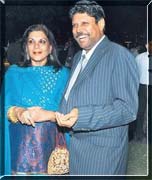 Business Interests• In 2005, Kapil selected up 5% venture in Zicom Electronics• Kapil possess the Kapil's Eleven (2006) restaurants in Chandigarh and Patna. He also holds the Kaptain's Retreat Hotel (1983; renovated and reopened in 2002) in Chandigarh. • Kapil launched a company Dev Musco Lighting Pvt Limited in affiliation with Musco Lighting to install floodlights in major stadiums and sports venues in India. Floodlight ventures incorporate PCA Stadium, GCA Stadium, Brabourne Stadium, Barabati Stadium, and Sector 16 Stadium. • Kapil has made cameo role appearances in the films Iqbal, Chain Khuli ki Main Khuli and Mujhse Shadi Karogi. EndorsementsKapil Dev has been energetically courted by Indian businesses during and after his cricketing days as brand ambassador for their products because of the charisma that exemplify the cricketer. Despite the fact that not the first Indian cricketer to endorse brands, he was the first star brand on Indian Television with his Palmolive ka jawab nahin (Translation: Palmolive has no match). He also emerges constantly on Headlines Today as a guest speaker. Other endorsements include:• Palmolive Shaving cream •BSA-SLR bicycles •Hero Honda bikes •Hajmola - 1995 •Crocin Pain Relief - 2005. •Boost (1980s & 130%0%s) •Sony SET Max - 2002. •Birla Sun-Life Insurance - 2006 •Chadha Group - 2006 •Kinetic - 2002 •Eastman Group - 2007 •Standard Chartered - 2003 •Rado - 2000 •Jaypee Greens - 2002 •Omaxe Construction - 2003 •Haier - 2007 •Idea Cellular - 2011 AchievementsAwards•1979-80 - Arjuna Award•1982 - Padma Shri •1983 - Wisden Cricketer of the Years 1•991 - Padma Bhushan •2002 - Wisden Indian Cricketer of the Century •2010 - ICC Cricket Hall of Fame
Test Match AwardsMan of Series Awards
Man of the Match Awards
ODI Match AwardsMan of the Series Awards
Man of the Match Awards
|

Common Games Of India || History Of Games& Sport || Pre School Games || School Games || Games For Girls & Women || Team Games

